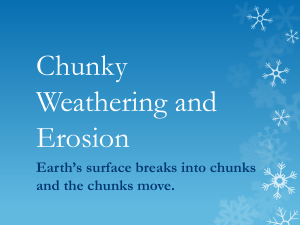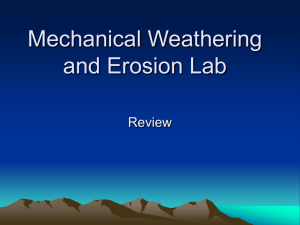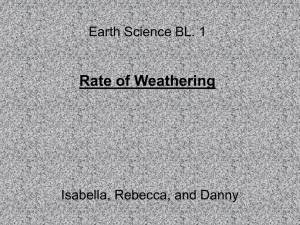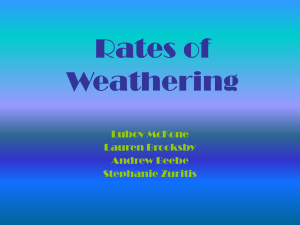Lecture 1 PPT - Arizona Geographic Alliance
advertisement
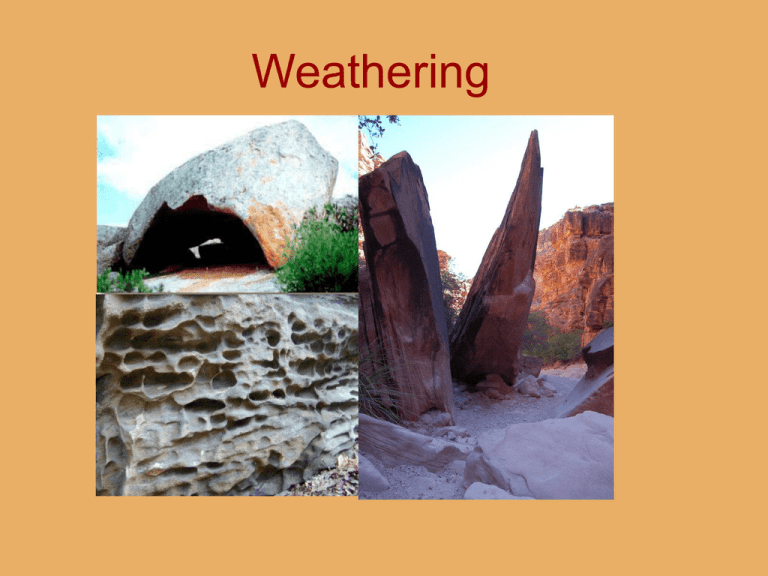
Weathering Weathering Lectures 1. Weathering vs. Erosion 2. Joints: Setting the Stages 3. 4. 5. 6. Physical (Mechanical) Weathering Chemical Weathering Products and Forms Made by Weathering Weathering Landscapes 1. Weathering vs. Erosion Common Error Made in K-12 Earth Science Teaching: these are synonyms No! Weathering – chemically dissolving candy or physically crunching candy – breakdown in place Erosion – moving pieces (dissolved or as fragments) 1st - Weathering = decay in place 2nd - Detach = break off 3rd Erode = move 1st – decayed 2nd – detached 3rd – eroded The balance between weathering and erosion defines the landscape In deserts – transport is faster Humans can upset the balance and accelerate erosion. So when transport (detachment and erosion) becomes faster than weathering, landscapes are not sustainable. s 2. Joints: Setting the Stage Joints – fractures (that allow water to penetrate and weather the rock) Not what you are thinking! 2. Joints: Setting the Stage Joints dependent on lithification (sedimentary & foliated metamorphic rocks) – where fractures occur along bedding planes or along foliations Joints independent of lithification (all rock types) – all other fractures Joints dependent on Lithification • Sedimentary Rocks – where fractures occur along bedding planes Joints dependent on lithification • Can also be Foliated Metamorphic Rocks – where fractures occur along bedding planes or along foliations Joints dependent of lithification Rocks can be cracked by cooling, leading To columnar jointing Columnar Jointing From contraction after lava flow cools Joints independent of lithification Rocks can be cracked by Tectonic Stresses or faulting/folding stresses the rock Joints can even fracture sedimentary strata from regional tectonic pressures Sandstone fractured across bedding planes Can have both together • Along bedding (& foliation) weaknesses and cutting across 3. Physical (Mechanical) Weathering • • • • • • • Abrasion Frost weathering Pressure release weathering Salt Weathering Thermal Expansion/Contraction Wetting/Drying Root pressure Abrasion • Often see abrasion by sediment or soil transport by water over rock… this both weathers (decays) and erodes by abrasion (like sand paper) Anthropogenic Abrasion • carving chiseling, bullet impacts Frost Weathering Check out these links Click here to see a fun movie clip about frost weathering Click here to see a 360 degree view of fractured rock in Antarctica by frost weathering Breaks rock along small fractures Breaks rock along large fractures & produces jagged alpine topography Aesthetic, so used in commercials Pressure Release pressure release shells Sometimes called “exfoliation” (like exfoliating skin) – incorrect usage Erosion removes overburden & shells pop off as pressure is released Glacial Erosion Great Way to Generate Pressure Release Salt Weathering Salt is common in deserts Salt is common along coasts Mechanics of Salt Weathering • Salt Crystal Growth: Extreme pressures in cracks and rock pores are caused by salt crystal growth from solution. There are varying causes of and extents to which salt growth occurs. • Thermal Expansion: During temperature fluctuations, salts trapped in pores may expand to a greater degree than the surrounding rock minerals. • Hydration: The hydration of various salts causes expansion & contraction, pushing apart the silicate host minerals Caverns (tafoni) Base of rock notching (basal weathering) Wedging tafoni – larger cavernous forms (Goudie and Viles, 1997:168) Alveoli – smaller cavernous forms: alveolization is the process Alveolization can occur from more than salt weathering, including insects & bird activity! Weathering along bases of rocks: basal notches Salt Efflorescence Salt subflorescence (salt under the surface) Salt subflorescence (salt under the surface – usually see when look at undersides of eroded flakes) fissuresol wedging & calcrete wedging Order from innermost crack out: calcrete – white calcium carbonate iron film – orange clays and iron rock varnish- outer edge black clays & manganese/Iron Wedging can split small rocks and giant boulders – carbonate & dust washes away – leaving iron film and rock varnish Thermal Expansion/Contraction • Thermal Expansion/Contraction A bit of moisture & sudden heat makes the rock pop – typically flakes (fingernail thick) but sometimes scales (thicker) “flaking” Wyoming rock art site Wetting/Drying Vermillion Cliffs Root Pressure creates weaknesses Simple Model of the Process • More than roots can affect rock. Plants growing next to rock art can burn and wind movement can abrade Imagery seen in this presentation is courtesy of ASU faculty, Paradise Valley and Mesa CC faculty, students and colleagues in other academic units, individual illustrations in scholarly journals such as Science and Nature, scholarly societies such as the Association of American Geographers, city, state governments, other countries government websites and U.S. government agencies such as NASA, USGS, NRCS, Library of Congress, U.S. Fish and Wildlife Service USAID and NOAA.




